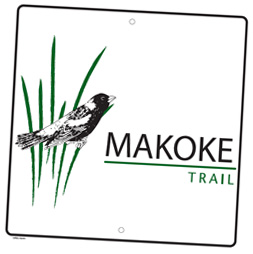The concept of "birding trails" is relatively new, possibly originating with the Great Texas Coastal Birding Trail in 1996. Now, less than two decades later, it is estimated there are some 300-400 birding trails scattered across the nation. These aren't trails in the traditional sense; rather, they're essentially driving routes that link prime birdwatching spots across a state or region.
This phenomenal growth in birding trails results from a growing interest in birding (now considered America's largest outdoor pastime) and realization that birding can contribute significantly to local economies. Birding trails users will stop to buy gas, eat lunch at a local restaurants, and stay overnight at a motel or B&B. Surveys indicate that birders often also shop for antiques, enjoy visiting wineries and will patronize these and many other vendors during breaks from their birding pursuits.
Iowa currently has three active birding trails: the Siouxland Trail in western Iowa's Loess Hills, the Great River Birding Trail paralleling the Mississippi, and the Makoke Trail in eight central Iowa counties. Map publications are available for each of Iowa's trails. A fourth trail (The Iowa Prairie Lakes Region) actually preceded development of the Great Texas Coastal Birding Trail and actually might have been among the nation's very first, but a map is currently out of print.
 The Makoke (pronounced "Mah-ko-kay") Trail officially debuted in May, 2009. Makokoe is a Native American word from our own namesake Ioway tribe, meaning "bird". Twenty-two sites were selected to represent some of the region's best birding opportunities, all within a 30-40 minute drive of Des Moines. A guidebook developed for the trail is fairly unique among the nation's birding trails, being one of the first to use high-quality aerial photos overlaid with names of major roads and symbols for best viewing spots and visitor centers. Each site map is accompanied by a description of the area's habitat and features, best times to visit, birds to look for, and notes about facilities and birding access. A complete list of the region's 304+ bird species is also included. At each trail site, birders will find primary access and viewing spots marked with special Makoke Trail and Watchable Wildlife Area signs.
The Makoke (pronounced "Mah-ko-kay") Trail officially debuted in May, 2009. Makokoe is a Native American word from our own namesake Ioway tribe, meaning "bird". Twenty-two sites were selected to represent some of the region's best birding opportunities, all within a 30-40 minute drive of Des Moines. A guidebook developed for the trail is fairly unique among the nation's birding trails, being one of the first to use high-quality aerial photos overlaid with names of major roads and symbols for best viewing spots and visitor centers. Each site map is accompanied by a description of the area's habitat and features, best times to visit, birds to look for, and notes about facilities and birding access. A complete list of the region's 304+ bird species is also included. At each trail site, birders will find primary access and viewing spots marked with special Makoke Trail and Watchable Wildlife Area signs.
The Makoke Trail was a joint project of Iowa DNR, Polk County Conservation Board, US Fish & Wildlife Service, US Army Corps of Engineers and USDA Natural Resources Conservation Service. Several additional partner groups contributed to printing so that the publication may be distributed to birders at no cost. Copies are available at major offices or visitor centers for each of the primary sponsor agencies. An on-line version may be viewed at IowaBirds.org - The Makoe Trail: A Guide to Birding in Central Iowa.
Another great resources is an interactive version of he National Audubon Society's Great River Birding Trail maps.
The Siouxland Bird Guide is not available online, but information about Siouxland birding hotspots and where to obtain the printed map may be found on the Loess Hills Audubon Society's website.